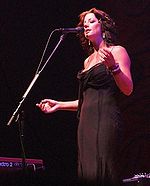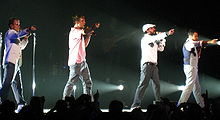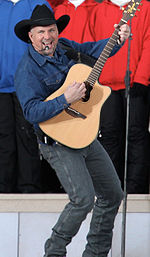- 1990s in music
-
For music from a year in the 1990s, go to 90 | 91 | 92 | 93 | 94 | 95 | 96 | 97 | 98 | 99
Popular music Timeline of musical events 2010s • 2000s • 1990s • 1980s • 1970s • 1960s • 1950s • 1940s • 1930s • 1920s • 1910s • 1900s • 1890s • 1880s • 1870s • 1860s • 1850s • 1840s • 1830s • 1820s • 1810s • 1800s • 1790s • 1780s • 1770s • 1760s • 1750s • 1740s • 1730s • 1720s • 1710s • 1700s • 1690s • 1680s • 1670s • 1660s • 1650s • 1640s • 1630s • 1620s • 1610s • 1600s • 1590s • 1580s • 1570s • 1560s • 1550s • 1540s • 1530s • 1520s • 1510s • 1500s • Early history List of popular music genres This article includes trends in popular music in the 1990s.
The decade saw the continuation of teen pop and dance-pop music which had emerged in the 1980s and continued to be popular in the 90s. Additionally, hip hop music, which had grown in popularity in the previous decade, was highly popular in the 90s, as the decade saw the continuation of the golden age of hip hop. Aside from rap, contemporary R&B and urban music in general remained extremely popular throughout the decade; urban music in the late-80s and 90s saw a fusion with styles such as soul, funk and jazz, resulting in fusion genres such as new jack swing and hip hop soul, which were popular in the decade. Similarly to the 1980s, rock music was also very popular in the 90s, yet, unlike the New Wave and glam metal-dominated scene of the time, grunge,[1] Britpop, industrial rock and other alternative rock music emerged and took over as the most popular of the decade, as well as pop punk, ska punk and nu-metal, amongst others, which reached a high level of success at different points throughout the decade. Electronic music, which had risen in popularity in the 1980s, grew highly popular in the 90s; 80s genres such as house and techno rose to international success in this decade, as well as new electronic genres such as trance, drum and bass, intelligent dance and trip hop. In Europe, Eurodance and Europop music became highly successful in the 90s,[2] also finding some international popularity too. The decade also featured the rise of contemporary country music as a major genre, which had started in the 1980s.[3]
Contents
- 1 The U.S. and North America
- 2 The U.K and Europe
- 3 Latin America
- 4 Australia and New Zealand
- 5 Asia
- 6 See also
- 7 References
- 8 External links
The U.S. and North America
Rock
Alternative Rock
 Red Hot Chili Peppers, 1991
Red Hot Chili Peppers, 1991
With the breakthrough of Nirvana and the popularity of the grunge and britpop movements in the 1990s, alternative rock entered the musical mainstream and many alternative bands became commercially successful during the 1990s.
By the start of the 1990s, the music industry was enticed by alternative rock's commercial possibilities and major labels actively courted bands including Jane's Addiction, Dinosaur Jr, and Nirvana.[4] In particular, R.E.M.'s success had become a blueprint for many alternative bands in the late 1980s and 1990s to follow; the group had outlasted many of its contemporaries and by the 1990s had become one of the most popular bands in the world.[5]
The Red Hot Chili Peppers became an important band in the rise of alternative rock with their album Blood Sugar Sex Magik bringing worldwide attention to alternative rock. Combining funk rock with more conventional rock, the Chili Peppers were able to achieve mainstream success climaxing with the release of Californication.
Some of the top mainstream American alternative rock bands of 1990s included Alice in Chains, Nirvana, The Offspring, Red Hot Chili Peppers, R.E.M., Soundgarden, Live, Counting Crows, Rage Against the Machine, Goo Goo Dolls, Third Eye Blind, Green Day, Bush, The Smashing Pumpkins, Beck, Foo Fighters, Sublime, Hole, Cake, Blind Melon, Stone Temple Pilots, blink-182 and Pearl Jam.
Grunge
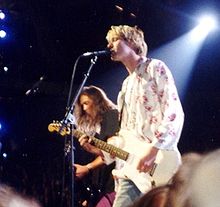 Nirvana is considered to have brought both grunge and alternative rock to the mainstream in late 1991
Nirvana is considered to have brought both grunge and alternative rock to the mainstream in late 1991
A sub-genre of alternative rock, grunge bands picked up popularity for the early 1990s. Grunge music, and the culture marketed around it, was born out of the Pacific Northwest American states of Washington and Oregon in the 1980s.[6] Artists such as Nirvana and Pearl Jam released seminal albums in 1991. The style would come to be strongly associated with the 1990s by the 2000s, and has been considered rock's last epochal era.[7]
Nirvana whetted the public's appetite for more direct, less polished rock music, and one place it was found was in the debut album from a hard-rocking West Coast band with ties to the grunge movement, a band named Pearl Jam. Pearl Jam had released its debut album Ten a month before Nevermind in 1991, but album sales only picked up a year later. By the second half of 1992 Ten became a breakthrough success, being certified gold and reaching number two on the Billboard 200 album chart.[8] Pearl Jam fused the riff-heavy stadium rock of the '70s with the grit and anger of '80s post-punk.
During the mid-1990s many grunge bands broke up or became less visible. The death of Kurt Cobain in early 1994, as well as the touring problems for Pearl Jam (which happened due to the band's much-publicized boycott of Ticketmaster), marked the decline of the genre.[9]
Post-grunge
 Foo Fighters, 2007
Foo Fighters, 2007
The death of Kurt Cobain in early 1994, as well as touring problems for Pearl Jam, marked a decline for grunge that year.[9] At the same time major record labels began signing and promoting bands that were emulating the genre.[10] The term post-grunge was coined to describe these bands, who emulated the attitudes and music of grunge, particularly thick, distorted guitars, but with a more radio-friendly commercially-oriented sound.[9]
In 1995, former Nirvana drummer Dave Grohl's new band, the Foo Fighters, helped popularize the genre and define its parameters, becoming one of the most commercially successful rock bands in the US, aided by considerable airplay on MTV.[11]
Some post-grunge bands, like Candlebox, were from Seattle, but the sub-genre was marked by a broadening of the geographical base of grunge, with bands like Los Angeles' Audioslave (which included both members Rage Against The Machine, and vocalist Chris Cornell of Soundgarden who was no stranger to the Seattle grunge movement), and Georgia's Collective Soul and beyond the US to Australia's Silverchair and Britain's Bush, who all cemented post-grunge as one of the most commercially viable sub-genres of the late 1990s.[12][13]
Indie rock
Following the immense success of Alternative rock in the 1990s, The term "Indie rock" became associated with the bands and genres that remained underground. Bands like Sonic Youth and The Pixies set the stage for the rise of indie rock in the underground scene, with bands such as Pavement and The Flaming Lips gaining popularity in the early years.
Pop punk
Pop punk in the United States underwent a resurgence in the early to mid 1990s. Pop punk at that time was not commercially viable, and no major record label signed a pop punk band until blink-182's breakthrough in 1997. Both these factors contributed to the emergence of a number of independent record labels, often run by people in bands in order to release their own music and that of their friends. The independent labels Lookout! Records, Fat Wreck Chords and Epitaph Records achieved commercial success after bands such as Green Day brought in a new audience for pop punk.
Pop punk broke into the mainstream in the mid-1990s, initially with the Northern California-based pop punk band Green Day and afterwords with the Southern California-based pop punk bands blink-182 and The Offspring as well whom all achieved massive worldwide commercial success. Green Day's album Dookie (1994) sold 10 million copies in the United States and 20 million copies worldwide. Soon after the release of Dookie, The Offspring released the album Smash. The album sold over 14 million copies worldwide, setting a record for most albums sold on an independent label. Also in the spring of 1994, Weezer released its debut album Weezer, most commonly known as The Blue Album, which peaked at number 16 on the charts and revived heavy radio and MTV rotation.[14] Rancid's Let's Go and NOFX's Punk in Drublic were also released during this period and both of them went gold as well. By the end of the year, Dookie and Smash had sold millions of copies.[15] The commercial success of these two albums attracted major label interest in pop punk, with bands such as Bad Religion being offered lucrative contracts to leave their independent record labels. In 1999, blink-182 released Enema of the State, which sold over 15 million copies worldwide.
This genre remained popular in America through the rest of the 1990s, the entire 2000s and the 2010s.
Nu metal and rapcore
In the early 90s, bands like Red Hot Chili Peppers, Rage Against the Machine, 311, Incubus and Cypress Hill brought a fresh sound by combining rap and rock with much success. These bands laid down the blueprints of rap metal and rapcore. In the middle of the decade this style, which contained a mix of grunge, metal, and hip hop, became known as nu metal. Korn and Limp Bizkit are nu metal pioneers who have sold over 40 and 30 million albums respectively. Their increasing popularity spawned a wave of successful bands like Linkin Park and P.O.D..
Heavy metal
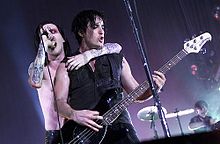 Trent Reznor and Marilyn Manson performing together at Madison Square Garden during the Fragility tour on May 9, 2000
Trent Reznor and Marilyn Manson performing together at Madison Square Garden during the Fragility tour on May 9, 2000
Many subgenres of heavy metal developed outside of the commercial mainstream during the 1980s.[16] In the early 1990s the Thrash metal genre achieved breakout success, mainly due to the massive success of Metallica's eponymous 5th album which was released in 1991 and brought thrash metal to the mainstream for the first time. Metallica's success was followed by Megadeth's Countdown to Extinction (1992) which hit number 2,[17] Anthrax and Slayer cracked the top 10,[18] and albums by regional bands such as Testament and Sepultura entered the top 100.[19]
In the later half of the decade Industrial Metal became popular. The top mainstream American Industrial Metal bands of 1990s included include Nine Inch Nails, Marilyn Manson, White Zombie, KMFDM, Ministry, and Fear Factory.
Other trends
Third wave pop metal artists such as Firehouse, Warrant, Extreme, Slaughter, and Skid Row experienced their greatest success at the start of the decade, but these bands' popularity waned after 1992 or so. Motley Crue and Poison, who were hugely popular in the 1980s, released successful albums in 1989 and 1990, respectively, and continued to benefit from that success in the early part of the decade. The Black Crowes ushered in a more classic rock 'n' roll sound with their successful debut in 1990. More well-established hard rock artists such as Guns N' Roses, Van Halen, Def Leppard, Ozzy Osbourne, Tom Petty, and Meat Loaf released successful albums and remained very popular in the first half of the decade, while Aerosmith, Bon Jovi, Metallica, and U2 maintained their popularity throughout the entire decade, largely by re-inventing themselves with each new album and exploring different sounds.
Rap rock, rap metal, rapcore and Nu Metal all had their peak of success in the '90s with bands such as Rage Against the Machine, Korn, Limp Bizkit, Slipknot, and Disturbed.
By the late 1990s, mainstream interest in third wave ska bands such as The Mighty Mighty Bosstones and No Doubt waned as other music genres gained momentum.[20]
Adult Contemporary/Soft rock and singer-songwriter
A revival of the singer-songwriter movement of the 1970s, closely connected to Third-wave feminism and the Lilith Fair, this movement lasted up to about 2002 with artists like Norah Jones and Sarah McLachlan. Important artists include Alanis Morissette, Tori Amos, Edwin McCain, Jewel, Natalie Merchant and Sheryl Crow. Perhaps the most important album of this movement was the many-times platinum Jagged Little Pill by Alanis Morissette as well as Tuesday Night Music Club and the 1996 eponymous album by Sheryl Crow.[21]
Also in the 1990s, artists such as Dave Matthews, Shania Twain, Bryan Adams, Elliott Smith, Melissa Etheridge, as well as Sheryl Crow borrowed from the singer-songwriter tradition to create new acoustic-based rock styles.
In the early 1990s, Mariah Carey's hit singles such as "Vision of Love" (1990), "Love Takes Time" (1990), Whitney Houston's "All the Man That I Need" (1990) and "I Will Always Love You" (1992) topped the adult contemporary charts.[22]
Pop
Contemporary R&B and urban pop began throughout the 1990s, but was replaced by more pop music and dance music by a short time in 1999.
Between 1997 and 1999 American teen pop singers and groups including Backstreet Boys, *NSYNC, 98 Degrees, Hanson, Christina Aguilera, Britney Spears, Jennifer Lopez and Destiny's Child became popular, targeted younger members of Generation Y. British girl group The Spice Girls manage to break America, becoming the most commercially successful British Group in North America since The Beatles. Their impact brings about a widespread invasion of female teen pop acts. At the end of the decade, Britney Spears and Christina Aguilera had huge successes with their hit singles, "...Baby One More Time" and "Genie In A Bottle" in 1999. The two continue to top the charts in the next decade.
Popular Pop music artists include Hanson, Mariah Carey, Backstreet Boys, Salt-n-Pepa, Groove Theory, Bell Biv Devoe, Jodeci, Diana King, Tony! Toni! Tone!, Tara Kemp, 3T, Brownstone, Shanice, Paula Abdul, Usher, SWV, Aaliyah, Keith Sweat, R. Kelly, TLC, Brandy, Monica, Tevin Campbell, Maxi Priest and Shaggy.
Madonna's Erotica was released in 1992 and became one of her most controversial albums to date. Cyndi Lauper's, released Hat Full of Stars her first mature album and leaves complete the image of his first two albums, but it is highly praised by critics but did not achieve commercial success.
Contemporary R&B
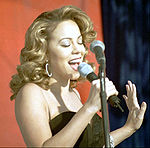 Mariah Carey is considered to be the biggest R&B act of the decade and the best-selling female artist of the decade.
Mariah Carey is considered to be the biggest R&B act of the decade and the best-selling female artist of the decade.
In the 1990s, Mariah Carey's career originated in quiet storm, with hit singles such as "Vision of Love" (1990), and "Love Takes Time" (1990) Also in the early 1990s, Whitney Houston's quiet storm hit included "All the Man That I Need" (1990) and "I Will Always Love You" (1992).[22] Richard J. Ripani wrote that Carey and Houston, "both of whom rely heavily on the gospel music vocal tradition, display an emphasis on melisma that increased in R&B generally over the 1980s and 1990s."[22] Carey's "Vision of Love" is considered to be an extreme example of the use of melisma.[22] Also during the early 1990s, Boyz II Men re-popularized classic soul-inspired vocal harmonies. Michael Jackson incorporated new jack swing into his 1991 album Dangerous, with sales over 32 million.[23][24] The popularity of the ballad and R&B leads to the development of a genre called Urban adult contemporary. Popular American contemporary R&B artists included Michael Bolton, Kenny G, Celine Dion, Mariah Carey, D'Angelo, Lauryn Hill, Whitney Houston, Sade, En Vogue, Toni Braxton, Boyz II Men, Dru Hill, Gloria Estefan, Vanessa L. Williams and LeAnn Rimes.
In contrast to the works of Boyz II Men, Babyface and similar artists, other R&B artists from this same period began adding even more of a hip hop sound to their work. The synthesizer-heavy rhythm tracks of new jack swing was replaced by grittier East Coast hip hop-inspired backing tracks, resulting in a genre labeled hip hop soul by producer Sean Combs. The style became less popular by the end of the 1990s, but later experienced a resurgence.
During the mid 1990s, Janet Jackson, Mariah Carey, TLC, SWV and Boyz II Men brought contemporary R&B to the mainstream. Jackson's self-titled fifth studio album janet. (1993), which came after her historic multi-million dollar contract with Virgin Records, sold over ten million copies worldwide.[25][26] Boyz II Men and Carey recorded several Billboard Hot 100 #1 hits, including "Fantasy", "One Sweet Day", a collaboration between both acts, which became the longest-running #1 hit in Hot 100 history. Carey, Boyz II Men and TLC released albums in 1994 and 1995—Daydream, II, and CrazySexyCool respectively — that sold over ten million copies, earning them diamond and also making them the best selling female R&B group of all time. RIAA certification.
In the late 1990s, neo soul, which added 1970s soul influences to the hip hop soul blend, arose, led by artists such as D'Angelo, Erykah Badu, Lauryn Hill, and Maxwell. Hill and Missy Elliott further blurred the line between R&B and hip hop by recording both styles. Beginning in 1995, the Grammy Awards enacted the Grammy Award for Best R&B Album, with II by Boyz II Men becoming the first recipient. The award was later received by TLC for CrazySexyCool in 1996, Tony Rich for Words in 1997, Erykah Badu for Baduizm in 1998 and Lauryn Hill for The Miseducation of Lauryn Hill in 1999. At the end of 1999, Billboard magazine ranked Mariah Carey and Janet Jackson as the first and second most successful artists of the 1990s.[27]
Mariah Carey's duet with Boyz II Men "One Sweet Day" which was recorded in 1995 spent 16 weeks atop the Hot 100 and became the only single in history to do so, was pronounced song of the decade, charting at number one on the decade-end chart.
Hip hop
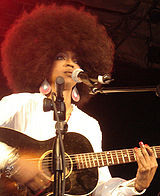 Lauryn Hill was one of the most successful Hip hop female artists of the 1990s.
Lauryn Hill was one of the most successful Hip hop female artists of the 1990s.
Dr. Dre's 1992 album The Chronic provided a template for modern gangsta rap.[28] Due to the success of Death Row Records, West coast rap dominated hip hop during the early 1990s, along with The Notorious B.I.G. on the East Coast.[29] Hip hop became the best selling music genre by the mid 1990s.[30]
In 1998, Lauryn Hill released her debut album The Miseducation of Lauryn Hill, which debuted at number one on the Billboard 200. In 1999, The Miseducation was nominated for 10 Grammy's, winning five (which at the time was unheard of for a hip-hop artist) and eventually went on to sell over 19 million copies worldwide.[31]
By the end of the 1990s attention turned back towards dirty south and crunk, with artists such as Outkast, Ludacris, Missy Elliot and Lil Wayne.[32]
The mid nineties were marked by the deaths of the West Coast-based rapper 2Pac and the East Coast-based rapper The Notorious B.I.G., which conspiracy theorists claim were killed as a result of the East Coast–West Coast hip hop rivalry.
Electronic music
 Moby, 2009
Moby, 2009
With the explosive growth of computers, music technology and consequent reduction in the cost of equipment in the early 1990s, it became possible for a wider number of musicians to produce electronic music. Even though initially most of the electronic music was dance music, the genre developed in the 1990s as musicians started producing music which was not necessarily designed for the dance-floor but rather for home listening (later on referred to as "Electronica") and slower paced music which was played throughout chillout rooms—the relaxation sections of the clubs (later on referred to as "downtempo", "chill-out music" and "ambient music").
In the late 1990s Madonna had success with her album Ray of Light which experimented with electronica sounds. Moby achieved international success in the ambient electronica scene after releasing his critically acclaimed album Play in 1999 which produced an impressive eight hit singles (including his most popular songs "Porcelain", "Natural Blues" and "Why Does My Heart Feel So Bad?").
Electronic dance music was highly successful throughout the decade in Europe, particularly in Britain, Germany and Italy. Outdoor raves were popular at the start of the decade in the UK, before the government introduced its Criminal Justice and Public Order Act 1994, leading to a higher number of superclubs opening. Among the most successful were Ministry Of Sound and Cream. Before the ban, popular genres at these raves included breakbeat hardcore and techno, though in the mid-1990s these genres splintered into separate scenes, such as happy hardcore, jungle and drum and bass, the latter of which received mainstream recognition through artists such as Goldie and Roni Size.
Other notable British genres that emerged during the decade include progressive house, big beat, vocal house, trip hop and UK Garage (or Speed Garage). The latter genre developed in London in the late 1990s and continued to be successful through to the early 2000s. DJ Culture also gained momentum during the 1990s. DJs such as Sasha, John Digweed, Paul Oakenfold, Ferry Corsten and Pete Tong became big names in the business, which was made desirable by magazine such as Mixmag and Muzik.
Italy ended the 1980s with Italo House, before becoming one of many countries to release Eurodance and Hi-NRG. Both genres were commercially successful across the world, with artists such as 2 Unlimited, La Bouche and Captain Hollywood promoting the genre. Countries such as Germany and Belgium, however, developed harder, darker styles of music, namely gabber, hard trance and techno. Trance emerged in the early 1990s and by the end of the decade had penetrated most of Europe, with artists such as ATB, Ferry Corsten and Paul Van Dyk gaining huge commercial and underground success. European trance remained popular until the early 2000s. Goa became famed for its goa trance parties and Ibiza became the Number 1 clubbers' holiday destination.
Country music
The popularity of country music exploded in the early 1990s. The stage had been set in 1989 with the debuts of several performers who proved to be profoundly influential on the genre during the 1990s and beyond. Most notable of that group was Garth Brooks, who shattered records for album sales and concert attendance throughout the decade. The RIAA has certified his recordings at a combined (128× platinum), denoting roughly 113 million U.S. shipments.[33] Brooks recorded primarily in a honky-tonk style, although he frequently combined elements of soft rock and arena rock in his songs. His songs sometimes explored social themes, such as domestic violence (in "The Thunder Rolls") and racial harmony ("We Shall Be Free)", while others — such as "Friends in Low Places" — were just good-time songs.
Other performers who rose in popularity during the early 1990s were neo-traditionalists Clint Black and Alan Jackson and southern rock influenced Travis Tritt. Mary Chapin Carpenter had a folk-style about her, while Lorrie Morgan (the latter the daughter of the late George Morgan, himself a country legend) blended elements of country and pop, and occasionally operatic sounds in songs such as "Something in Red." Trisha Yearwood was one of the top new singers of 1991, while Diamond Rio blended traditional and bluegrass styles and Brooks & Dunn provided a driving honky-tonk sound.
During the 1990s, country music's mainstream popularity became so great that Time magazine devoted a cover story detailing the genre's history and reasons for its growing popularity.[citation needed]
During the early-to-middle part of the decade, several recordings were influenced by the popularity of line dancing, including "Boot-Scootin' Boogie" by Brooks & Dunn and "Achy Breaky Heart" by Billy Ray Cyrus. This influence was so great that Chet Atkins was quoted as saying "The music has gotten pretty bad, I think. It's all that damn line dancing."[34]
A steady stream of new artists began their careers during the mid- and late-1990s. Many of these careers were short-lived, but several went on to long-lived, profitable careers. The most successful of the new artists were Shania Twain, LeAnn Rimes, Lee Ann Womack, Martina McBride, Kenny Chesney, Collin Raye, Faith Hill and Tim McGraw, while Lonestar and Dixie Chicks were the most successful new groups. Shania Twain's Come on Over album became the best-selling album released by a female of any genre.
Among artists whose success continued from the 1980s, Reba McEntire was one of the most successful of the female artists, selling more than 20 million albums during the decade (including her best-selling album, Greatest Hits Vol. 2, at 6.9 million copies) and topping the Billboard Hot Country Singles & Tracks chart six times from 1990-1998. George Strait, a neo-traditionalist whose national success began in the early 1980s, enjoyed success as both a radio artist (17 No. 1 songs) and as a movie star (1993's Pure Country). Alabama, the most successful country band of the 1980s, continued their run of popularity with sell-out concerts and best-selling albums, while topping the country chart five times. Among older artists having big hits, Conway Twitty was one of the most successful, scoring two Top 3 hits with "Crazy in Love" and "I Couldn't See You Leaving," while Eddie Rabbitt had a No. 1 hit with "On Second Thought." Although his 1990s singles never reached the top 20, George Jones (who had been around since the 1950s) regularly recorded and released critically acclaimed material, including the semi-autobiographical "Choices." Other artists reaching the top 10 of the Hot Country Singles & Tracks chart were Waylon Jennings, Anne Murray and Kenny Rogers.
Pop-influenced country music began growing in popularity, particularly after Twain and Hill rose in popularity in the latter half of the 1990s. In 1998, Hill's "This Kiss" and Twain's "You're Still the One" both reached the top 10 of the Billboard Hot 100, in addition to peaking at No. 1 on the Hot Country Singles & Tracks chart. Rimes had a multi-million selling hit with "How Do I Live" (a song successfully covered by Yearwood), while Lonestar also had a huge crossover hit with "Amazed." Although the occurrence of country crossing over to the pop charts goes back as far as the start of the Billboard charts in 1940, some critics began to be troubled by a trend toward what they perceived as pop music marketed as country; they contended that radio was concentrating more on newer music while ignoring the more traditional styles of older artists such as Merle Haggard, George Jones and others who continued to record and release new material. Johnny Cash and producer Rick Rubin once purchased a full-page advertisement in Billboard magazine — after Cash's album Unchained won a Grammy for Best Country Album, despite a lack of support from radio — showing a young Cash displaying his middle finger and sarcastically "thanking" radio for supporting the album.
In the 1990s, alternative country came to refer to a diverse group of musicians and singers operating outside the traditions and industry of mainstream country music. In general, they eschewed the high production values and pop outlook of the Nashville-dominated industry, to produce music with a lo-fi sound, frequently infused with a strong punk and rock & roll aesthetic, bending the traditional rules of country music. Lyrics were often bleak, gothic or socially aware. Other initiators include Old 97's, Steve Earle, Uncle Tupelo, Son Volt, Ryan Adams, My Morning Jacket, Blitzen Trapper, and Drive-By Truckers.
A number of notable artists in country music died during the decade, including Twitty, Tennessee Ernie Ford, Roy Acuff, Roger Miller, Charlie Rich, Gene Autry, Roy Rogers, Tammy Wynette, Eddie Rabbitt and Hank Snow.
Billboard Artist of the Decade
On December 1999, Billboard Magazine named Mariah Carey as the best Artist of the Decade for the 1990s. She joined the list with Elvis Presley, The Beatles, Elton John and Michael Jackson, who have also been awarded with this prestigious honor in their respective decades.[citation needed]
In 1999, Selena was named the "top Latin artist of the '90s" and "Best selling Latin artist of the decade" by Billboard, for her fourteen top-ten singles in the Top Latin Songs chart, including seven number-one hits.[35] The singer also had the most successful singles of 1994 and 1995, "Amor Prohibido" and "No Me Queda Más".[36]
The U.K and Europe
See also: Music of the United Kingdom (1990s)Rock
Britpop
In the early 1990s a counter-culture movement rose in Britain, called Britpop by the music press, rejecting the themes of disenfranchised youth coming out of America in favor of a songs written specifically about the experiences of the British youth. Although the movement was heavily influenced by 1960s, 1970s, and 1980s British rock there was very little that musically defined the Britpop bands beyond the intensely British lyrical themes. Britpop bands such as Blur, Suede, Pulp, Elastica, Supergrass, The Verve and Oasis regularly topped the singles and album charts throughout the decade. Oasis were the biggest band of the Britpop scene and the only band to make a significant impact in the US market. The Britpop phenomena ran out of steam by the end of the 1990s with most of its most successful bands splitting up or fading away.
Post-Britpop
From about 1997 Britpop as a movement began to dissolve, emerging bands began to avoid the Britpop label while still producing music derived from it.[37][38] Many of these bands tended to mix elements of British traditional rock (or British trad rock),[39] particularly the Beatles, Rolling Stones and Small Faces,[40] with American influences, including post-grunge.[41][42] Post-Britpop bands like The Verve, Radiohead, Travis, Stereophonics and Feeder, achieved much wider international success than most of the Britpop groups that had preceded them, and were some of the most commercially successful acts of the late 1990s.[42][43][44][45]
Other trends
The Irish Celtic folk rock band The Corrs achieved international success during the late 1990s with a series of hit recordings which established them as international stars and helped a successful career that continued into 2000s.
Pop
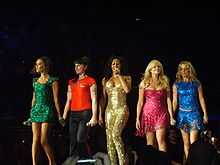 Spice Girls became one of the biggest global pop acts of the decade
Spice Girls became one of the biggest global pop acts of the decade
 Robbie Williams, 2009
Robbie Williams, 2009
Pop music and dance music became popular throughout the 1990s. Popular European Pop artists of the 1990s included Seal, Jamiroquai, Milli Vanilli, Right Said Fred.
During the 1990s some European managers created their own Boy band acts, beginning with Nigel Martin-Smith's Take That and Louis Walsh's East 17, which competed with Irish bands Westlife and Boyzone.[46] In 1996, the male saturated market was tuned on its head by one of the most successful and influential pop acts of the decade, the Spice Girls. The group achieve nine number 1 singles in the UK and US, including "Wannabe", "2 Become 1" and "Spice Up Your Life" [47] The group, unlike their British boy band predecessors, manage to break America and achieve the best-selling album of 1997 in the USA. More Girl Groups begin to emerge such as All Saints, who had five number 1 hits in the UK and two multi-platinum albums.[48] By the end of the century the grip of boy bands on the charts was faltering, but proved the basis for solo careers like that of Robbie Williams, formally of Take That, who achieved six number one singles in the UK between 1998 and 2004.[48] Additional popular European Teen pop acts of the 1990s include Ace of Base, Aqua and A*Teens.
Ballad songs were popular during this decade, popular European artists included George Michael, Robert Palmer, Sade, Lisa Stansfield and Roxette.
In the summer of 1996 The Spanish music duo Los del Río popularized the dance craze "Macarena" with their hit smash summer hit "Macarena". The song was featured prominently in many other countries during the mid 1990s.
Electronic music
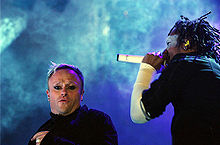 The English electronic dance music group The Prodigy was one of the most successful Electronic music artists of the 1990s.
The English electronic dance music group The Prodigy was one of the most successful Electronic music artists of the 1990s.
 The Dutch Eurodance act 2 Unlimited was one of the most successful Electronic music artists of the 1990s.
The Dutch Eurodance act 2 Unlimited was one of the most successful Electronic music artists of the 1990s.
With the explosive growth of computers music technology and consequent reduction in the cost of equipment in the early 1990s, it became possible for a wider number of musicians to produce electronic music.
The popularity of house, techno and rave in the early part of the decade leads to the boom of the more commercial Eurodance genre. Popular European Eurodance acts of the decade include:Alexia, Vengaboys, 2 Unlimited, Cappella, Corona, Culture Beat, DJ Bobo, Dr. Alban, Ice MC, La Bouche, 2 Brothers On The 4th Floor, Maxx, Sash!, Snap!, Playahitty, Real McCoy and Whigfield. Eventually the popularity of the Eurodance genre leads to the huge popularity of the trance genre in the late 1990s and early 2000s.
The 1990s also saw the development and refinement of IDM (Intelligent Dance Music), which borrowed from forms such as techno, drum and bass, and acid house music and introduced more abstract elements, including heavy use of digital signal processing.[49] Among the most commercially successful products in the 1990s of these scenes were European acts such as The Prodigy, The Chemical Brothers and Fatboy Slim, Aphex Twin, Autechre, Boards of Canada and Squarepusher.
The arrival of Massive Attack in the early 1990s leads to a new style of slow electronic music, that is dubbed Trip Hop and influences groups such as Portishead, Björk, Tricky, Morcheeba and Thievery Corporation.
Additional popular and commercially successful European electronic music artists of the 1990s include Leftfield, LFO, Massive Attack, Portishead, Underworld, Mr. Oizo and Vitalic.
Latin America
Pop
In 1991 21-year-old singer Luis Miguel rediscovers the bolero, echoing back to the trios of the 1940s with his album Romance. He becomes the biggest international Latin star until the late 1990s.
No Mercy, Chayanne and Thalía also becomes an international hit.
In 1998 Ricky Martin eclipses Luis Miguel as the top Latin star as he performs The Cup of Life during the 1998 World Cup and releases Livin' La Vida Loca which would become an international hit.
In the mid-1990s, Puerto Rican singer Jennifer Lopez and Mexican-American singer Selena became popular.
By the early 1990s, Puerto Rico becomes a merengue stronghold, with acts such as Elvis Crespo, Olga Tañon and Grupo Mania topping the charts throughout Latin America.
After Selena's death, Colombian singer Shakira and Spanish-Filipino singer Enrique Iglesias began to rise into the top of the pop charts by the end of the decade.
Rock
Surge of newfound interest in Spanish-language rock, led by bands like Soda Stereo, Café Tacuba or Los Tres which gained large international following during this period. Others would follow their footsteps.
Along with the rise of Spanish rock came "rock alternativo", a Spanish equivalent to alternative rock headed by bands like Los Piojos, Babasonicos and Attaque 77. The "rolinga" or "stone rock" genre also emerged from "rock alternativo", popularized and headed throughout the entire decade by Viejas Locas. The stone-rock genre would remain popular in the 2000s with the Viejas Locas' vocalist, Pity Álvarez's other band, Intoxicados.
Salsa
During the 90s salsa spread from the Caribbean region all over Latin America sharing the dance music niche with cumbia. During this period salsa became also increasingly popular as dance music in the USA and Europe. Beginning in 1990, the salsa romantica that began in the 1980s becomes a standard in tropical music thanks to chart-topping stars mainly from Puerto Rico such as Marc Anthony, Jerry Rivera, Tito Rojas, Víctor Manuelle and Gilberto Santa Rosa.
Cumbia
In the 90s the popularity of cumbia waned in favour of other styles such as salsa but remained relatively strong. In Argentina, Mexico, El salvador and other countries as well syntetizers and elemetyns of electronic music were incorporated into cumbia giving birth to cumbia sonidera, cumbia andina mexicana and cumbia villera. The blending of chibcha music and cumbia in Peru also gained large popularity.
Australia and New Zealand
Bands INXS and Crowded House, how had rose to international fame in the 1980s, continued their success into the nineties. However, INXS saw a decline in popularity after the release of 1993's Full Moon, Dirty Hearts, which did not even reach the US Top 50 and on 22 November 1997, a few months after the release of the band's tenth studio album Elegantly Wasted, lead singer Michael Hutchence was found dead in a Sydney hotel room. Crowded House released two further albums, 1991's Woodface and 1994's Together Alone, which were both successful internationally, but disbanded in 1996 after playing their Farewell to the World concert at the steps of the Sydney Opera House. Their greatest hits compilation album Recurring Dream, released in 1996, debuted at number one in Australia, New Zealand and the United Kingdom and reached the Top 20 in several European territories.
Australian singer Kylie Minogue, who quickly rose to fame in the late eighties, continued to be popular throughout the decade. The nineties also saw the emergence of pop singer Peter Andre, pop band Human Nature, Tina Arena and R&B Hip Hop artists CDB and Deni Hines. Notable nineties Australian rock bands include Silverchair, Savage Garden, Powderfinger, and The Living End.
In New Zealand hip hop group OMC's single How Bizarre became the most successful New Zealand song in history, reaching number one in several music charts around the world, including Australia, Canada, Ireland, South Africa and Austria [50]. The nineties saw a surge in popularity of alternative rock music in New Zealand, especially the popularity of alternative rock bands from the independent music label Flying Nun Records. Successful alternative rock bands of this era include Straitjacket Fits, Headless Chickens and The Chills. Headless Chickens provided Flying Nun with their first number one New Zealand single in 1994 with their song George.
Asia
Tokyo based noise rock band Melt-Banana became an international touring cult act as well as the Boredoms.
See also
- 1980s in music
- 2000s in music
References
- ^ http://www.allmusic.com/explore/style/grunge-d2679
- ^ http://www.allmusic.com/explore/style/euro-pop-d404
- ^ [Country Rocks, Monday, Mar. 30, 1992 - Time.com]
- ^ Azerrad (1994), p. 160
- ^ Erlewine, Stephen Thomas. "American Alternative Rock/Post-Punk". Allmusic. Retrieved May 20, 2006.
- ^ Yarm, Mark (2011-09-23). "Commentary: The roots of grunge run deep". CNN. http://www.cnn.com/2011/09/23/showbiz/music/roots-grunge-yarm/index.html. Retrieved 2011-10-27.
- ^ Montgomery, James (2011-09-14). "Nirvana's Nevermind Made 1991 Rock, But Was It The Greatest Year?". MTV.com. http://newsroom.mtv.com/2011/09/14/nirvana-nevermind-greatest-years-ever-in-rock-poll/. Retrieved 2011-10-23.
- ^ Pearlman, Nina. "Black Days." Guitar World. December 2002.
- ^ a b c "Post-grunge", Allmusic, retrieved 17 January 2010.
- ^ M. Azerrad, Our Band Could Be Your Life: Scenes from the American Indie Underground, 1981-1991, (Boston: Little Brown and Company, 2001), ISBN 0-316-78753-1, pp. 452–3.
- ^ V. Bogdanov, C. Woodstra and S. T. Erlewine, All Music Guide to Rock: the Definitive Guide to Rock, Pop, and Soul (Backbeat Books, 3rd edn., 2002), p. 423.
- ^ "Post-grunge", Allmusic, retrieved 31 December 2009.
- ^ V. Bogdanov, C. Woodstra and S. T. Erlewine, All Music Guide to Rock: the Definitive Guide to Rock, Pop, and Soul (Milwaukee, WI: Backbeat Books, 3rd edn., 2002), ISBN 0-87930-653-X, pp. 1344-7.
- ^ http://www.rollingstone.com/artists/theoffspring/albums/album/160074/review/21324403/smash
- ^ Bestseller lists and Diamond Certification available at the RIAA website: http://www.riaa.com/gp/bestsellers/diamond.asp
- ^ Weinstein (1991), p. 21
- ^ Billboard 200, chart date: 1992-08-01
- ^ Billboard 200, chart date: 1993-06-12; Billboard 200, chart date: 1994-10-15
- ^ Billboard 200 Chart Position: Testament – Ritual, chart date: 1992-05-30; Billboard 200 Chart Position: Sepultura – Chaos A.D., chart date: 1993-11-06
- ^ Gulla, Bob (2006). The Greenwood Encycloepdia of Rock History, Volume Six. Westport, Connecticut: Greenwood Press. pp. 47. ISBN 0-313-32981-8.
- ^ "1995 THE ENTERTAINERS/THE ROOKIES | Jagged Little Pill | Cover Story | News | Entertainment Weekly". Archived from the original on 2009-05-08. http://www.ew.com/ew/article/0,,300150,00.html. Retrieved 2009-03-17.
- ^ a b c d Ripani, Richard J. (2006), The New Blue Music: Changes in Rhythm & Blues, 1950-1999, Univ. Press of Mississippi, pp. 130–155, 186–188, ISBN 1-57806-862-2
- ^ "Michael Jackson sulla sedia a rotelle". AffarItaliani.it. 2008-07-11. http://www.affaritaliani.it/entertainment/micheal-jackson110708.html. Retrieved 2009-05-10.
- ^ Carter, Kelley L. (2008-08-11). "New jack swing". Chicago Tribune. http://www.chicagotribune.com/features/arts/chi-5-things-0810aug10,0,1329158.story. Retrieved 2008-08-21.
- ^ Goldberg, M. (1991-05-02), "The Jacksons score big", Rolling Stone: 32, ISSN 0035791X
- ^ Bickelhaupt, Susan; Dezell, Maureen (1996-01-13), "Room with a private view", The Boston Globe: 26
- ^ Mayfield, Geoff (1999-12-25), "Totally '90s: Diary of a decade", Billboard 111 (112), ISSN 00062510
- ^ McGee, Allan (2008-01-03). "The missing link of hip-hop's golden age". The Guardian. http://www.guardian.co.uk/music/musicblog/2008/jan/03/thegoldenageofhiphop. Retrieved 2011-09-17.
- ^ Caramanica, Jon (2009-11-09). "MYTH No. 4: Biggie & Tupac Are Hip-Hop's Pillars". http://www.spin.com/articles/myth-no-4-biggie-tupac-are-hip-hops-pillars (SPIN).
- ^ Batey, Angus (2010-10-07). "The hip-hop heritage society". The Guardian. http://www.guardian.co.uk/music/2010/oct/07/hiphop-heritage-public-enemy-krs-one. Retrieved 2011-11-08.
- ^ Rolling Stone article: "Inside "The Miseducation of Lauryn Hill: page 1."
- ^ Reynolds, Simon (2009-11-26). "Simon Reynolds's Notes on the noughties: When will hip-hop hurry up and die?". The Guardian. http://www.guardian.co.uk/music/musicblog/2009/nov/26/notes-noughties-hip-hop. Retrieved 2011-08-25.
- ^ http://www.riaa.com/goldandplatinumdata.php?table=SEARCH_RESULTS
- ^ The Roots of Country Music" Collectors Edition by Life September 1, 1994
- ^ Mayfield, Geoff (December 25, 1999). "Totally '90s: Diary of a Decade". Billboard (Nielsen Business Media, Inc.) 111 (52): YE-16–18. ISSN 0006-2510. http://books.google.com.mx/books?id=9w0EAAAAMBAJ&pg=PA66&dq=selena. Retrieved March 30, 2010.
- ^ "Topping The Charts Year By Year". Billboard (Nielsen Business Media, Inc.) 110 (48): LMQ3. November 28, 1998. http://books.google.com/?id=MAoEAAAAMBAJ&pg=RA1-PA38&dq=rudy+la+scala&cd=1#v=onepage&q=rudy%20la%20scala. Retrieved March 3, 2010.
- ^ J. Harris, Britpop!: Cool Britannia and the Spectacular Demise of English Rock (Da Capo Press, 2004), ISBN 0-306-81367-X, pp. 369-70.
- ^ S. Borthwick and R. Moy, Popular Music Genres: an Introduction (Edinburgh: Edinburgh University Press, 2004), p. 188, ISBN 0-7486-1745-0.
- ^ "British Trad Rock", All Music, retrieved 3 January 2010.
- ^ A. Petridis, "Roll over Britpop ... it's the rebirth of art rock", The Guardian, 14 February 2004, retrieved 2 January 2010.
- ^ "You Gotta Go There to Come Back, Stereophonics", All music, retrieved 3 January 2010.
- ^ a b "Travis", All music, retrieved 3 January 2010.
- ^ M. Roach, This is it-: the first biography of the Strokes (Omnibus Press, 2003), pp. 42 and 45.
- ^ "Stereophonics", All Music, retrieved 3 January 2010.
- ^ "Coldplay", All music, retrieved 3 December 2010.
- ^ P. Shapiro, Turn the Beat Around: The Secret History of Disco (Basingstoke: Macmillan, 2006), pp. 288-9.
- ^ D. Sinclair, Wannabe: How the Spice Girls Reinvented Pop Fame (Omnibus Press, 2004), pp. 71-2.
- ^ a b N. Warwick, T. Brown, J. Kutner, The complete book of the British charts: singles & albums (Omnibus Press, 3rd edn., 2004), pp. 21-4.
- ^ J. Shepher and D. Laing, Continuum Encyclopedia of Popular Music of the World (Continuum, 2003), p. 179.
- ^ Easton, Paul (1 February 2010). "Pauly Fuemana mourned". Stuff.co.nz. http://www.stuff.co.nz/entertainment/music/3279973/Pauly-Fuemana-mourned. Retrieved 14 September 2011.
External links
- 90s Music - Grunge to Pop and Everything in Between
- 90s Music Hits
- 90s Music Videos - Music Videos from the 1990s
Categories:
Wikimedia Foundation. 2010.



